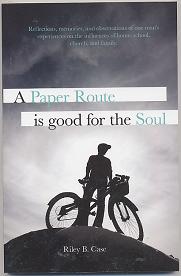A Paper Route is Good for the Soul
By Riley B. Case

Excerpt from page 93:
The seats were hard as I first remembered them, in the Big Church, the Mennonite Church in Berne, Indiana. And there were lots of seats, enough for 2,000 people, more if they were children, more if you counted the choir, room for more people in that church than there was population in the town; and the seats were always filled, at least for the Messiah, with people on extra chairs. Sometimes the newspapers estimated crowds of 3,000, but was in the days before fire marshals.
I remember being sleepy. It was hard to sleep when you are a little boy, when it is crowded and hot and the seats are hard. Methodist churches were discovering padded pews. Services seemed not quite so long with padded pews, and little children could sleep. But in the Big Church the seats were hard.
It only stood to reason. There would be no padded pews in the Big Church. In the 1860s, as I later read, the church had nearly split over the issue of tassels on buggies. Mennonites were plain people. Too much luxury meant compromise with the world. Any church which argued over tassels on buggies would never tolerate padded pews. Later in reflecting on it, I wondered whether my people, my great-grandparents and great-great uncles, and the myriads of ancestor cousins, were on the pro-tassel or anti-tassel side.
The Messiah was always long. Mennonites, so I came to believe, found no virtue in brevity. Methodists were programmed for one hour services. God and the preacher could have their hour, but not ten minutes more and preachers, if they did not know already, after one hour were on their own time. Not so for Mennonites. Mennonites, I am sure--at least for my cousins and the boys I knew--did not care for long services either. But they would never say so. To complain was unseemly, or even sinful. Mennonites did not believe in penance but they practiced it. One needed to suffer on hard seats as the sun passed across the sky to restore the proper relationship with God. The Messiah went on and on, as if the message was so great that nothing should be left out. And if it were left one year, it was so it could return another.
When I was old enough to read I would follow the program, figuring how much more time before we got to the end, which was the "Amen Chorus." But I forgot, or at least several years running, that just because we had come to the Amen Chorus, did not mean we were ready to quit. The Amen Chorus took six pages of music, with sopranos and tenors and altos and basses each taking turns, going up and down the scalw, a round and then a few more rounds, the sopranos lingering on a high A natural. Six pages of Amen was itself equal to two whole anthems in a Methodist church. But of course it was logical. Amen does not really mean the end. It means so be it. And if we sang about the gospel, so be it, and be it, and be it, and be it, and be it.
